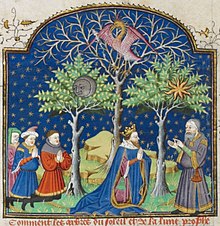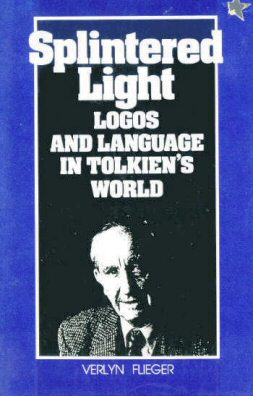Splintered light

The Tolkien scholar Verlyn Flieger has described in her book Splintered Light the progressive splintering of the first created light, down through successive catastrophes, leaving smaller and smaller splinters as the ages pass. In brief, the creator Eru Iluvatar forms the universe, Eä, with innumerable stars; these light the Earth, Arda, when it is created. [9] [T 2]
Angelic beings, the Valar, live in the centre of Arda, lit by two enormous lamps, Illuin and Ormal, atop mountainous pillars of rock. The "Years of the Lamps" are abruptly brought to an end when the lamps are destroyed by the fallen Vala Melkor; the powerful fiery light spills out and destroys everything around it. The world is remade with new seas and reshaped continents, no longer symmetrical; the Valar leave Middle-earth for Valinor. [9]
The Vala Yavanna, goddess of plants, does her best to recreate the light, in the form of the Two Trees of Valinor, the silver Telperion and the gold Laurelin; they alternately brighten and dim, overlapping to create periods of "dawn" and "dusk". The light of the "Years of the Trees" is gentler than the lamps, lighting only Valinor: Middle-earth lies in darkness. [9] [T 3] The Two Trees exude droplets of light which the Vala Varda (who the Elves call Elbereth) catches in vats; she uses the dew from Telperion to shape bright new silver stars to give at least some light to the Elves of Middle-earth. [9] [T 4]
The splintering continues. In the First Age, Fëanor, the most skilled of all Elven-smiths, makes his finest work, the three Silmarils, forged jewels containing some of the light of the Two Trees. [10] [T 5] The making of the Silmarils is timely, as Melkor returns, bringing the insatiable giant spider Ungoliant to devour the Two Trees and absorb all their light into her darkness. These contain the only remaining true light not poisoned by Ungoliant. [10] [T 6]
Yavanna and Nienna manage to save the last flower of Telperion, which becomes the Moon, and the last fruit of Laurelin, which becomes the Sun. These splinters of light are formed into ships to cross the sky, steered by spirits. [10] [T 7]
The Silmarils are fought over in ruinous wars, as narrated in the Quenta Silmarillion. Eventually all are lost: one ends up in the sea, one is buried in the Earth, and one is sent into the sky: by the grace of Elbereth, it is carried by Eärendil the mariner, forever sailing his ship across the heavens, appearing as the Morning and Evening Star (the planet Venus). The light is still visible, but is now inaccessible to Middle-earth. [10] [T 8]
The island kingdom of Númenor has as its living symbol Nimloth, the White Tree, a seedling of another tree like Telperion, though it does not shine. The Men of Númenor become proud, cease to worship the One God, Eru Ilúvatar, and rebel against the Valar. The White Tree is cut down and burned. The Valar call on Eru Ilúvatar, who reshapes the world to be round. The island of Númenor is drowned, with most of its people, [T 9] in a fall recalling both the drowning of Atlantis, as intended by Tolkien, [T 10] and the biblical stories of the fall of man and the destruction of Sodom and Gomorrah. [11] Isildur brings one fruit of Nimloth to Middle-earth; it grows as the White Tree of Gondor. [10]
Eventually the splinters become as small as the Phial of Galadriel, which she had filled with light gathered from her fountain as it refracted the light of the Star of Eärendil. The Phial enables Frodo and Sam to defeat the giant spider Shelob, descendant of Ungoliant, on their way to Mordor to destroy the Ring. The Ring contains the power of Sauron, the remaining servant of Melkor on Middle-earth. [12]
| Age | Blue/Silver light | Golden light | Jewels |
|---|---|---|---|
| Years of the Lamps | Illuin, sky-blue lamp of Middle-earth, atop tall pillar, Helcar | Ormal, high-gold lamp of Middle-earth, atop tall pillar, Ringil | |
| ending when Melkor destroys both Lamps | |||
| Years of the Trees | Telperion, silver tree, lighting Valinor | Laurelin, golden tree, lighting Valinor | Fëanor crafts 3 Silmarils with light of the Two Trees. |
| ending when Melkor strikes the Two Trees, and Ungoliant kills them | |||
| First Age | Last flower becomes the Moon, carried in male spirit Tilion's ship. | Last fruit becomes the Sun, carried in female spirit Arien's ship. | |
| Yavanna makes Galathilion, a tree like Telperion, except that it does not shine, for the Elves' city of Tirion in Valinor. | There is war over the Silmarils. | ||
| Galathilion has many seedlings, including Celeborn on Tol Eressëa | One Silmaril is buried in the Earth, one is lost in the Sea, one sails in the Sky as Eärendil's Star. | ||
| Second Age | Celeborn has seedling Nimloth, the White Tree of Númenor. | ||
| Númenor is drowned. Isildur brings one fruit of Nimloth to Middle-earth. | |||
| Third Age | A White Tree grows in Minas Tirith while a King rules Gondor. | Galadriel collects light of Eärendil's Star reflected in her fountain mirror. | |
| The tree stands dead while Stewards rule. | A little of that light is captured in the Phial of Galadriel. | ||
| The new King Aragorn brings a White Sapling into the city. | Hobbits Frodo Baggins and Sam Gamgee use the Phial to defeat the giant spider Shelob. | ||
Thus the light begins in The Silmarillion as a unity, and in accordance with the splintering of creation is divided into more and more fragments as the myth progresses. At each stage, the fragmentation increases and the power decreases, mirroring the decline and fall of Middle-earth. [13]










